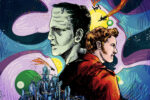One might think that Bram Stoker’s “Dracula” would have died by now, but instead, its popularity is as immortal as the titular vampire. Since its publication in 1897, Bram Stoker’s most famous novel has been adapted into dozens of movies, including Bela Lugosi’s famous portrayal in 1931’s “Dracula.” However, the novel has not been read quite as widely, leaving many outside of college English lit courses mostly unfamiliar with the source material.
Perhaps that’s about to change, for the latest popular incarnation is not a movie. It’s not even a modern rewrite. Rather, it’s the entire original novel, in chronological order, sent out as a series of emails from the “Dracula Daily” Substack. The novel’s epistolary format lends itself to the transformation into what its creator calls “bite-sized chunks,” easily digestible for an online audience with a short attention span.
Matt Kirkland’s brainchild “Dracula Daily” is just the latest in his series of quirky, obscure projects. His other projects range from Dumb Cuneiform, which for $20 will transliterate tweets (and other short messages) into cuneiform on tiny clay tablets, to The Charles Williams Library, which publishes editions of obscure Charles Williams novels for the Charles Williams Society. Yet far from obscure, “Dracula Daily” has attracted over 200,000 readers for 2022, its second year. This may be a surprise, given the simple newsletter’s humble inspiration. Kirkland first thought of the concept while reading the book with his daughter in the summer of 2020. But the effortless, streamlined delivery has made regular reading a short and simple exercise, easy to be picked apart and shared.
With its unique format, “Dracula Daily” grants the reader the ability to experience the classic novel in a new, modern way, without the imposing presence of a thick tome. While Stoker set a careful tension-building pace between chapters, “Dracula Daily” adheres to a strict chronological approach. Here the suspense lies in the days or weeks that transpire in between entries for each character. When something happens to one of the characters, it may be days or weeks before we hear from them again, during which time we alternate between concerning silence and other plotlines.
Besides the suspense, the chronological format has other benefits, most notably allowing us to experience the novel in the same time frame as the characters. When Jonathan Harker finds himself locked in Dracula’s castle, he may go days or weeks between writing in his journal, leaving us acutely aware of how much time has elapsed. When he later escapes, readers check their inbox to discover his success, only to get literary whiplash while reading about Renfield’s perplexing spider collection. Such whiplash occurs repeatedly, juxtaposing Harker’s house of horrors against the affectionate letters between best friends Mina and Lucy.
Just as importantly, having shorter daily chunks of text refocuses the reader’s attention on the details rather than the broad sweeps of the plot. Jonathan loves Mina and collects recipes for her, but can’t handle paprika. Pretending to have a fully staffed household, Dracula acts as his own chef and coachman, going so far as to make Jonathan’s bed. Meanwhile, the three vampire women who live with him do nothing around the castle except cackle and taunt whenever Jonathan is within reach. Back in England, Lucy tells Mina she wishes she could marry all three of her suitors. Every few days, we get a paragraph-long update from Dr. Seward about his unusual patient, Renfield, and his fly — then spider — collection, some of the strangest entries in the book. In the novel, these observations come as part of the same chapter, garnering little notice.
Going more in-depth on the dramatis personae shows that there are several prominent characters besides the titular Count Dracula. First, we have the naïve Jonathan Harker, a newly minted solicitor (lawyer) who had the great misfortune of being sent by his boss, Peter Hawkins, to close a real estate deal with Dracula. There is Mina Murray, who marries Jonathan during the novel, and her best friend, Lucy Westenra. Lucy herself has three suitors, all old friends. Arthur Holmwood, heir to the title Lord Godalming, wins Lucy’s heart and hand in marriage, American cowboy Mr. Quincey P. Morris reads like the stereotype he is and psychiatrist Dr. John Seward runs a “lunatic asylum,” taking notes by tape recorder to distract himself after Lucy’s rejection.
Reading “Dracula” in modern times yields both humor and discomfort, in addition to the intended horror. Much of the novel’s unintentional irony comes from the fact that none of the characters know they’re in “Dracula.” Gifted with a cross, Jonathan Harker wants to ask Dracula why all the villagers are so superstitious about vampires. Just before Dracula throws his shaving glass across the room, Harker wonders why the count doesn’t have a reflection in the mirror. Sailors vanish from a ship and the captain finds it odd. While bats fly around, two unhealing bite marks appear on Lucy but no one suspects vampirism. Another part of the humor comes from simple details, like Jonathan and his paprika, or Dracula crawling down walls in “lizard fashion.”
On the other hand, discomfort comes from the obvious racism in many scenes throughout the book. Some have criticized the character of Dracula himself as an antisemitic stereotype, with his physical attributes, his money, and his aversion to Christianity. Beyond his coding of the villain as Jewish, Stoker gives other stereotypes less subtle treatment. Very quickly, one can go from thrilled at an update from Jonathan Harker, to dismayed at the racist vitriol he hurls against Dracula’s highly mischaracterized Romani helpers. His sexism in the treatment of Mina and Lucy and the mocking of the “New Woman” also become disquieting. However, it is just as unsurprising as racism from a 19th-century white man.
Nonetheless, “Dracula” remains a defining gothic work, a model for vampires and horror since its release. While full of stereotypes, it has spawned as many novels and movies as there are wolves at Castle Dracula. Recognizing the source material for what it is — something both pivotal and flawed — is important. And just as important, we must recognize the well-written and more diverse successors to “Dracula.”
So after “Dracula Daily” concludes, where does one turn next? Many have pointed to Mary Shelley’s “Frankenstein” (1818) for its shared genre and epistolary format. Written by a woman as a rebuke to the work of men, it serves as a great historical counterpoint. Also authored by a woman, Anne Rice’s “Interview with the Vampire” (1976) is the first in a series following the vampire Lestat and has been adapted into a movie starring Tom Cruise. Another option might be Sheridan Le Fanu’s “Carmilla” (1872), a novella about a female vampire predating “Dracula” by 26 years. For a change of pace, one might even consider modern-day popular works like “Twilight,” geared toward adolescent girls.
However, in many cases, these newer novels showcase a lack of diversity less excusable in modern times. Besides, the girls who once read “Twilight” may be the ones reading “Dracula” now, 10 years later. In the end, the most important thing is to read widely and think critically. And if you have to travel for school or work, remember to pack a good book and heed the locals’ warnings to avoid gothic castles.

















